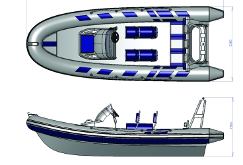The historic town of Dartmouth in the UK has a long maritime history, being the last staging post of the Pilgrim Fathers en route to the New World.
Ribeye’s Deep V hulls were designed to cope with the UK’s choppy seas so have excellent handling capabilities
Today the town is home to one of the world’s leading high-tech rigid inflatable boat builders. Ribeye has successfully married the tradition and craftsmanship of boat building with the latest materials, construction techniques and global supplychain management processes.
“The luxury boat industry has faced a number of challenges during the recent economic downturn. Customers continue to demand high-performance, top quality products, but at increasingly competitive
price points,” says Ribeye founder and CEO, Charles Chivers.
“The lightweight and rigid construction aluminium hulls on our latest generation of rigid inflatable boats enable excellent performance in terms of both top speed and durability. To offer this performance at
a competitive price point we have engaged manufacturing partners in Asia where the hull skins are now produced before being finally assembled and quality inspected in the UK.”
Tradition meets technology
The design process for Ribeye’s next generation boats involves a combination of both CAD and manually crafted scale mock-ups.
A single Phase Vision Quartz 800 scanner is used to capture and reverse engineer mock-ups, which are suspended from a gantry to allow 360 degree access.
Several scans are required to capture each hull. Phase Vision’s proprietary GemAlign software then automatically stitches the scans together ready for export into Polyworks for back-end processing.
Cross-section slices of the hull are created, which Ribeye can then transfer electronically to its Asian manufacturing partner to define the tooling for the metal forming process.
“Getting to market with the latest designs in time for show season is critical to us. Curved surfaces and complex shapes make hulls incredibly difficult to measure, with certain critical features having a significant impact on performance,” comments Ribeye’s sales director, John Wood.
“As a partner of Yamaha Engines it is critical for us to ensure that our boats not only look good, but also offer best-in-class performance on the water. The reverse engineering process has been a bottleneck in the past, both in terms of the time it takes to measure a hull and the limited resolution of data supplied back.
Phase Vision solved both these issues for us allowing our designs to be transferred to manufacture ahead of schedule for next season’s product launch.”
Phase Vision tools aid design for speedboat manufacturer Ribeye
Default






